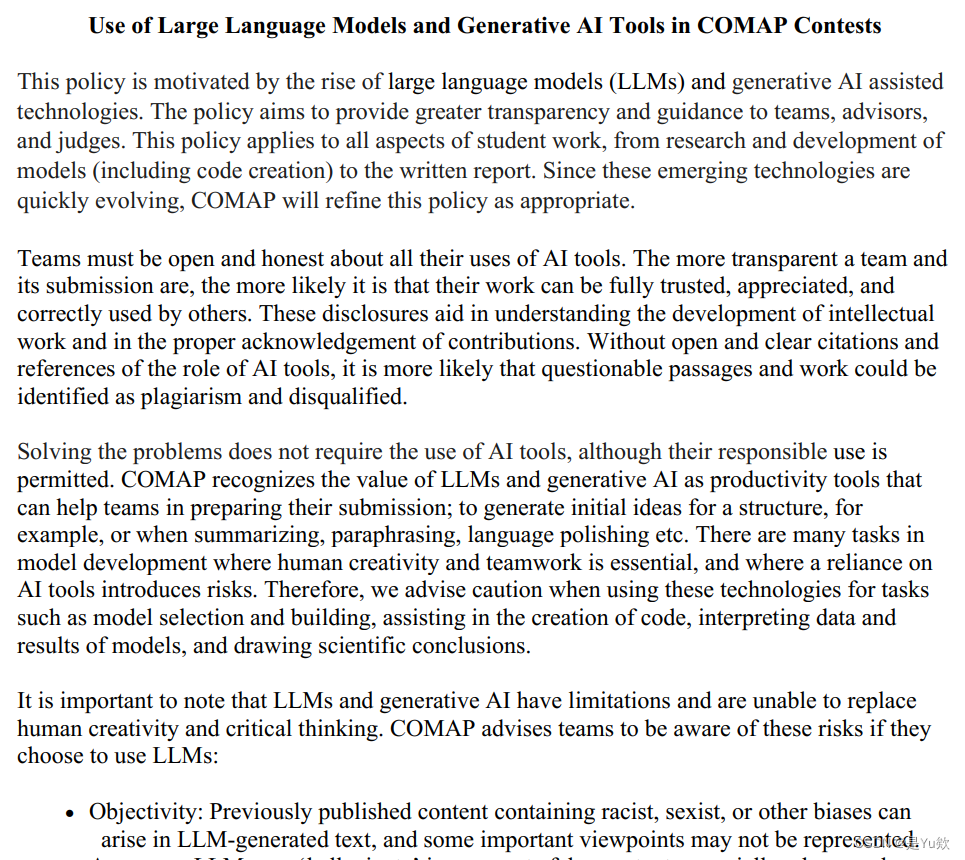【2024美赛】在COMAP比赛中使用大型语言模型和生成式AI工具的政策Use of Large Language ModelGenerative AI Tools in COMAP Contests_美赛使用翻译软件算使用大模型吗-程序员宅基地
技术标签: 经验分享 数学建模 美赛 笔记 翻译 2024 人工智能
【2024美赛】在COMAP比赛中使用大型语言模型和生成式AI工具的政策Use of Large Language ModelGenerative AI Tools in COMAP Contests
- 写在最前面
-
- 2024美赛翻译 —— 跳转链接
- 中文翻译
-
- 在COMAP比赛中使用大型语言模型和生成式AI工具的政策
- 团队指南
- 当我们识别出可能是未声明使用此类工具准备的提交时,COMAP将采取适当行动。
- 引用和参考文献指南
- AI使用报告
- 英文原文
-
- Use of Large Language Models and Generative AI Tools in COMAP Contests
-
- Guidance for teams
- COMAP will take appropriate action when we identify submissions likely prepared withundisclosed use of such tools.
-
- Citation and Referencing Directions
- Report on Use of AI
写在最前面
注:中文初稿由ChatGPT-4自动翻译,Yu进行了细节上的完善和调整,欢迎留言补充。本文仅供学习和交流使用,祝大家取得超乎预期的好成绩!

2024美赛翻译 —— 跳转链接
【2024美赛】在COMAP比赛中使用大型语言模型和生成式AI工具的政策Use of Large Language ModelGenerative AI Tools in COMAP Contests
【2024美赛】A题(中英文):资源可用性与性别比例Problem A: Resource Availability and Sex Ratios
【2024美赛】B题(中英文):搜寻潜水器Problem B: Searching for Submersibles
【2024美赛】C题(中英文):网球中的势头Problem C: Momentum in Tennis
【2024美赛】D题(中英文):五大湖水资源问题Problem Problem D: Great Lakes Water Problem
【2024美赛】E题(中英文):房产保险的可持续性Problem E: Sustainability of Property Insurance
【2024美赛】F题(中英文):减少非法野生动物贸易Problem F: Reducing Illegal Wildlife Trade
中文翻译
在COMAP比赛中使用大型语言模型和生成式AI工具的政策
这项政策是由于大型语言模型(LLMs)和生成式AI辅助技术的兴起而提出的。该政策旨在为团队、顾问和评委提供更大的透明度和指导。这项政策适用于学生工作的所有方面,从研究和开发模型(包括代码创建)到书面报告。由于这些新兴技术正在迅速发展,COMAP将适时对这一政策进行完善。
团队必须对使用AI工具的所有情况开放和诚实。团队及其提交的内容越透明,其工作就越有可能被完全信任、赏识并被他人正确使用。这些披露有助于理解智力工作的发展和对贡献的适当认可。如果没有对AI工具的作用进行开放和明确的引用和参考文献,那么可疑的段落和工作更有可能被识别为抄袭并取消资格。
解决问题不需要使用AI工具,尽管允许负责任地使用它们。COMAP认识到LLMs和生成式AI作为生产力工具的价值,这些工具可以帮助团队准备他们的提交;例如,生成结构的初步想法,或在总结、改写、语言润色等方面。在模型开发的许多任务中,人类的创造力和团队合作是必不可少的,而依赖AI工具引入风险。因此,我们建议在使用这些技术进行模型选择和构建、辅助创建代码、解释模型的数据和结果以及得出科学结论等任务时谨慎行事。
重要的是要注意,LLMs和生成式AI有其局限性,无法取代人类的创造力和批判性思维。如果团队选择使用LLMs,COMAP建议团队注意这些风险:
- 客观性:之前发布的包含种族主义、性别歧视或其他偏见的内容可能出现在LLM生成的文本中,一些重要的观点可能不被代表。
- 准确性:LLMs可能会“幻想”即生成虚假内容,特别是在超出其领域或处理复杂或模棱两可的主题时。它们可以生成在语言上但非科学上合理的内容,它们可以搞错事实,并且已经显示出它们可以生成不存在的引用。一些LLMs只训练了特定日期之前发布的内容,因此呈现了一个不完整的画面。
- 上下文理解:LLMs不能将人类理解应用于文本的上下文,特别是在处理成语表达、讽刺、幽默或比喻性语言时。这可能导致生成内容中的错误或误解。
- 训练数据:LLMs需要大量高质量的训练数据才能达到最佳性能。然而,在某些领域或语言中,这样的数据可能不容易获得,从而限制了任何输出的有用性。
团队指南
团队需要:
- 在报告中明确指出使用LLMs或其他AI工具,包括使用了哪个模型以及用途。请使用文中引用和参考文献部分。还需在你的25页解决方案之后附上AI使用报告(如下所述)。
- 验证由语言模型生成的内容及任何引用的准确性、有效性和适当性,并纠正任何错误或不一致之处。
- 提供引用和参考文献,按照这里提供的指导。仔细检查引用以确保它们准确且得到适当引用。
- 意识到抄袭的潜在风险,因为LLMs可能会复制其他来源的大量文本。检查原始来源以确保你没有抄袭别人的工作。
当我们识别出可能是未声明使用此类工具准备的提交时,COMAP将采取适当行动。
引用和参考文献指南
仔细考虑如何记录和引用团队可能选择使用的任何工具。各种风格指南开始纳入AI工具引用和参考的政策。在你的25页解决方案的参考文献部分使用文中引用,并列出所有使用的AI工具。
无论团队是否选择使用AI工具,主要解决报告仍限制在25页。如果团队选择使用AI,在报告结束后,添加一个名为AI使用报告的新部分。这个新部分没有页数限制,不计入25页解决方案内。
示例(这不是详尽无遗的 - 根据你的情况调整这些示例):
AI使用报告
- OpenAI ChatGPT(2023年11月5日版本,ChatGPT-4)
Query1:<输入你向AI工具输入的确切措辞>
Output:<插入AI工具的完整输出> - OpenAI Ernie(2023年11月5日版本,Ernie 4.0)
Query1:<输入你对AI工具的任何后续输入的确切措辞>
Output:<插入第二次查询的完整输出> - Github CoPilot(2024年2月3日版本)
Query1:<输入你向AI工具输入的确切措辞>
Output:<插入AI工具的完整输出> - Google Bard(2024年2月2日版本)
Query:<输入你的查询的确切措辞>
Output:<插入AI工具的完整输出>
英文原文
Use of Large Language Models and Generative AI Tools in COMAP Contests
This policy is motivated by the rise of large language models (LLMs) and generative AI assisted technologies. The policy aims to provide greater transparency and guidance to teams, advisors, and judges. This policy applies to all aspects of student work, from research and development of models (including code creation) to the written report. Since these emerging technologies are quickly evolving, COMAP will refine this policy as appropriate.
Teams must be open and honest about all their uses of AI tools. The more transparent a team and its submission are, the more likely it is that their work can be fully trusted, appreciated, and correctly used by others. These disclosures aid in understanding the development of intellectual work and in the proper acknowledgement of contributions. Without open and clear citations and references of the role of AI tools, it is more likely that questionable passages and work could be identified as plagiarism and disqualified.
Solving the problems does not require the use of AI tools, although their responsible use is permitted. COMAP recognizes the value of LLMs and generative AI as productivity tools that can help teams in preparing their submission; to generate initial ideas for a structure, for example, or when summarizing, paraphrasing, language polishing etc. There are many tasks in model development where human creativity and teamwork is essential, and where a reliance on AI tools introduces risks. Therefore, we advise caution when using these technologies for tasks such as model selection and building, assisting in the creation of code, interpreting data and results of models, and drawing scientific conclusions.
It is important to note that LLMs and generative AI have limitations and are unable to replace human creativity and critical thinking. COMAP advises teams to be aware of these risks if they choose to use LLMs:
- Objectivity: Previously published content containing racist, sexist, or other biases can arise in LLM-generated text, and some important viewpoints may not be represented.
- Accuracy: LLMs can ‘hallucinate’ i.e. generate false content, especially when used outside of their domain or when dealing with complex or ambiguous topics. They can generate content that is linguistically but not scientifically plausible, they can get facts wrong, and they have been shown to generate citations that don’t exist. Some LLMs are only trained on content published before a particular date and therefore present an incomplete picture.
- Contextual understanding: LLMs cannot apply human understanding to the context of a piece of text, especially when dealing with idiomatic expressions, sarcasm, humor, or metaphorical language. This can lead to errors or misinterpretations in the generated content.
- Training data: LLMs require a large amount of high-quality training data to achieve optimal performance. In some domains or languages, however, such data may not be readily available, thus limiting the usefulness of any output.
Guidance for teams
Teams are required to:
- Clearly indicate the use of LLMs or other AI tools in their report, including which model was used and for what purpose. Please use inline citations and the reference section. Also append the Report on Use of AI (described below) after your 25-page solution.
- Verify the accuracy, validity, and appropriateness of the content and any citations generated by language models and correct any errors or inconsistencies.
- Provide citation and references, following guidance provided here. Double-check citations to ensure they are accurate and are properly referenced.
- Be conscious of the potential for plagiarism since LLMs may reproduce substantial text from other sources. Check the original sources to be sure you are not plagiarizing someone else’s work.
COMAP will take appropriate action when we identify submissions likely prepared withundisclosed use of such tools.
Citation and Referencing Directions
Think carefully about how to document and reference whatever tools the team may choose to use. A variety of style guides are beginning to incorporate policies for the citation and referencing of AI tools. Use inline citations and list all AI tools used in the reference section of your 25-page solution.
Whether or not a team chooses to use AI tools, the main solution report is still limited to 25 pages. If a team chooses to utilize AI, following the end of your report, add a new section titled Report on Use of AI. This new section has no page limit and will not be counted as part of the 25-page solution.
Examples (this is not exhaustive – adapt these examples to your situation):
Report on Use of AI
- OpenAI ChatGPT (Nov 5, 2023 version, ChatGPT-4)
Query1:<insert the exact wording you input into the AI tool>
Output:<insert the complete output from the AI tool> - OpenAI Ernie (Nov 5, 2023 version, Ernie 4.0)
Query1:<insert the exact wording of any subsequent input into the AI tool>
Output:<insert the complete output from the second query> - Github CoPilot (Feb 3, 2024 version)
Query1:<insert the exact wording you input into the AI tool>
Output:<insert the complete output from the AI tool> - Google Bard (Feb 2, 2024 version)
Query:<insert the exact wording of your query>
Output:<insert the complete output from the AI tool>


智能推荐
2022年全国职业院校技能大赛高职组云计算正式赛卷第三场-公有云_chkrootkit入侵检测工具,安装完毕后使用chkrootkit工具扫描系统,并将扫描结果保存-程序员宅基地
文章浏览阅读1.7k次,点赞25次,收藏18次。在公有云上的主机时刻面临被攻击的危险,除了可以购买云安全服务,还可以自行部署。安全在公有云服务中占很大的比重,而日志分析服务可以很有效的分析日志规避部分风。创建云主机,需要等待成功该云主机后,返回查询该云主机信息。通过华为云控制台,选择北京四区域,创建一台。创建待成功,再返回查询该云主机的信息,结果以。)登录方式:使用密码登录, 密码自定义。)登录方式:使用密码登录, 密码自定义。成后, 提交该云主机的用户名、密码和公网。云主机管理与云主机操作系统性能远程监控。和配置参数, 成功查询具体名称云主机,_chkrootkit入侵检测工具,安装完毕后使用chkrootkit工具扫描系统,并将扫描结果保存
关于UE4通过python获取静态网格体插槽的问题_python ue4模型获取材质插槽-程序员宅基地
文章浏览阅读899次。之前做项目可以很轻松的获取skeletal mesh的材质插槽,但是静态mesh没有同样的功能。于是在google 搜到了一个答案,在此记录一下:Ok, so the function get_material_slot_names() is a method of the StaticMeshComponent class. So you are able to retrieve the materials from base StaticMesh class by first creating a _python ue4模型获取材质插槽
基于网络的入侵检测数据集研究综述(A Survey of Network-based Intrusion Detection Data Sets)-程序员宅基地
摘要:该综述论文对基于网络的入侵检测数据集进行了分析和总结,强调了标记数据在训练和评估入侵检测系统中的重要性。文章建议用户在多个数据集上进行评估,避免过度拟合和人为影响,并提倡使用标准格式的数据集和预定义的训练和测试子集。总的来说,虽然没有完美的数据集,但有许多好的数据集可供使用,社区可以通过更密切的合作从中受益。
centos部署http代理+解决国内服务器TGbot_tg内置代理账号密码-程序员宅基地
文章浏览阅读2.9k次。使用tgbot需要代理才能使用,参考各路大神,把适合自己的方法总结如下,本人小白,大佬勿喷:首先,先把带密码的http代理的使用方法写上http://账号:密码@ip:port部署安装openssl判断是否安装opensslopenssl version -a安装命令yum install openssl安装squidyum install squid -y# -y 代表自动选择y,全自动安装安装net-toolsyum install net-tools修改squi_tg内置代理账号密码
正则匹配相邻n个重复字符_正则匹配多个字符串重复n次-程序员宅基地
文章浏览阅读1.9k次。正则匹配相邻n个重复字符//var reg = /([0-9a-zA-Z])\1{n-1}/;var reg = /([0-9a-zA-Z])\1{2}/;reg.test('2333');//true_正则匹配多个字符串重复n次
哨兵2号(Sentinel2)卫星数据处理_哨兵二号数据处理-程序员宅基地
文章浏览阅读3.9w次,点赞13次,收藏150次。李国春哨兵2号数据是一个重要的共享免费数据源,原来我就知道这个数据的应用很受重视,可是没想到现在在国内是如此空前的重视。哨兵数据处理人家ESA有自己的SNAP处理软件,非常好的软件。RSD也来凑凑热闹,也加了处理哨兵2号卫星数据的功能。介绍RSD处理哨兵数据之前先夸夸这数据,数据质量真好。但是最让我感动的还是人家的元数据,写的那是真好啊,看来值得我们学习的东西还有很多。好了,言归正传。..._哨兵二号数据处理
随便推点
OpenHarmony 音频特性架构设计和移动端开发_openharmony 音频架构-程序员宅基地
文章浏览阅读61次。然后,我们可以根据设计好的架构进行具体的音频特性开发,例如音频录制、播放和处理等。通过合理的架构设计和灵活的开发,开发者可以充分发挥 OpenHarmony 平台的优势,实现高质量的音频应用。在上面的示例中,我们创建了一个音频录制器对象,并设置了音频源为麦克风,输出格式为 MPEG-4,音频编码器为 AAC。除了基本的录制和播放功能,OpenHarmony 还提供了音频处理的能力,例如音频混音、音频特效等。1.1 确定功能需求:首先,明确你的应用需要实现的具体音频功能,例如音频录制、播放、音频处理等。_openharmony 音频架构
数组 常用工具类_工具类构件空数组-程序员宅基地
文章浏览阅读528次。增删元素会引起数组元素数量改变,都是先创建容量正好的新数组,再拷贝、添加需要的元素,返回新数组。各个基本类型、引用类型的空数组。_工具类构件空数组
c语言开发ndk,Android NDK开发之旅7--C语言基础--IO-程序员宅基地
文章浏览阅读80次。读写文本文件主要用到了fgets和fputs两个函数(函数名中的s是指String,字符串的意思):#define_CRT_SECURE_NO_WARNINGS#include#includevoidmain(){//文件路径char*path="D:\\test.txt";char*path_new="D:\\test_new.txt";//打开文件,返回文件的指针FILE*f..._ndk io操作
CSDN官方猿如意工具体验_猿如意是干嘛的-程序员宅基地
文章浏览阅读3.5k次,点赞2次,收藏4次。猿如意是一款面向开发者的辅助开发工具箱,包含了效率工具、开发工具下载,教程文档,代码片段搜索,全网搜索等功能模块。帮助开发者提升开发效率,帮你从“问题”找到“答案”。具体详细信息查看上面官网。_猿如意是干嘛的
matlab 三维曲线投影怎么画-程序员宅基地
文章浏览阅读1.9k次,点赞2次,收藏3次。Matlab 提供了许多用于绘制三维曲线的函数。你可以使用 plot3 函数绘制三维曲线,并使用 view 函数来调整视图,使得曲线投影在平面上。以下是一个示例代码:t = 0:0.1:10;x = sin(t);y = cos(t);z = t;plot3(x, y, z)view(-35, 45)这将绘制一条三维曲线,并使用视角为 -35 度在 x-y 平面上投影,以 45 ..._matlab三维图投影到指定平面
stc8h单片机利用websocket协议通过esp8266将数据传输到服务器_esp8266连接websocket指令-程序员宅基地
文章浏览阅读333次。在STC8H单片机上使用WebSocket协议通过ESP8266传输数据到WebSocket服务器,然后接收和解析服务器下发的数据,涉及到嵌入式开发、网络通信以及WebSocket协议的使用。:ESP8266是一个低成本的Wi-Fi模块,它可以将STC8H采集的数据封装成WebSocket消息并通过Wi-Fi网络传输到WebSocket服务器。:WebSocket服务器是一个网络服务器,它能够接收来自ESP8266的WebSocket消息,处理它们,并向连接的设备发送WebSocket消息。_esp8266连接websocket指令